In the following sections, we will give you a comprehensive guide of six key waitlist metrics that you should monitor.
We’ll be covering some familiar ones, like the average wait time, along with lesser-known ones, like waitlist abandonment and performance analytics.
Mastering these metrics can help you turn frustratingly long wait times into an efficient service that customers love, and get you more revenue in the end.
Let’s start off easy with the importance of tracking your average wait time.
Table of contents
- Average Wait Time
- Wait Time Estimate Accuracy
- Waitlist Turnover
- Waitlist Abandonment
- Waitlist Performance Analytics
- Customer Feedback
- Conclusion
Average Wait Time
The average wait time may be an obvious metric to track, but that doesn’t change the fact that it’s an incredibly important one for your restaurant operations.
No one likes waiting, and mismanaged restaurant waitlists and endless queues can have a major impact on customers.
According to data derived from 94,404 customers over the course of a year, long wait times can have three undesirable behavioral effects, as shown in the image below.
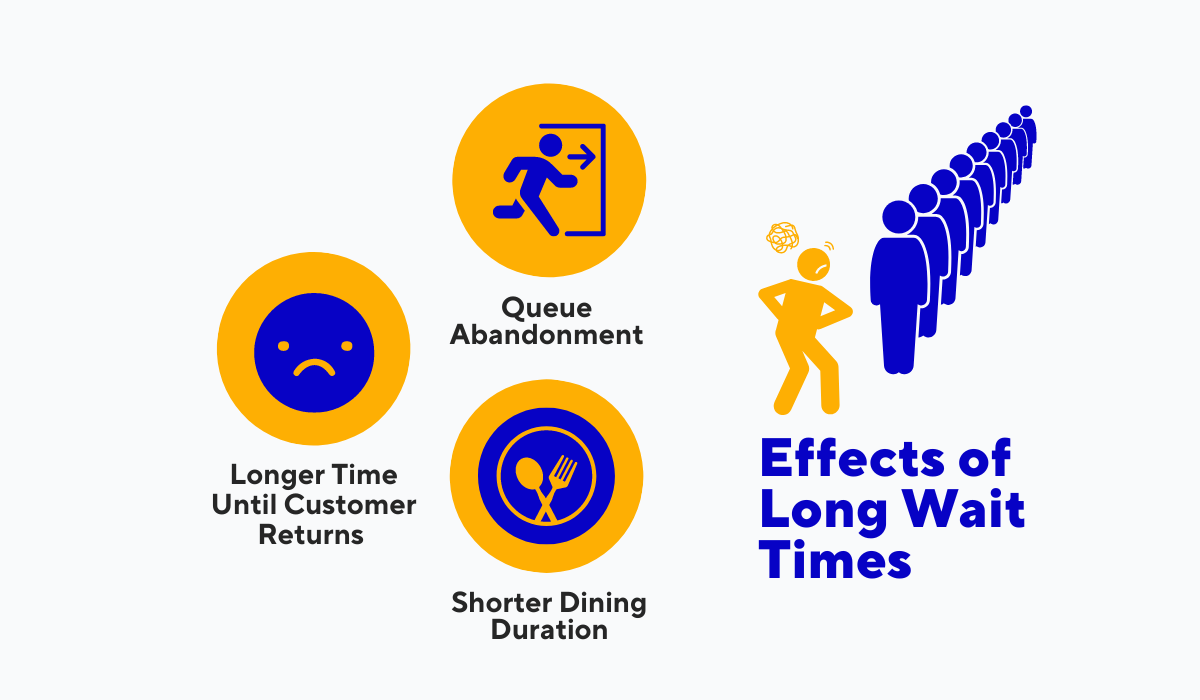
Illustration: Tablein / Data: Science Direct
So, to keep your guests coming back and prolong the duration of their dining, tracking average wait times is essential.
Instruct your staff to monitor this metric over a set period, say a month, and then evaluate this data to see if you are keeping your guests waiting too long.
You can compare your findings with the ones in the following image, showing the reported acceptable wait times according to a 2022 survey by TastingTable.

Illustration: Tablein / Data: TastingTable
According to the data, you should seat most guests in less than 30 minutes, as 80% of the 588 respondents said this would be an acceptable waiting time.
More specifically, 50% would wait 15-30 minutes, while 26% wouldn’t be satisfied waiting more than 15 minutes.
To conclude, understanding and optimizing your average wait time is essential to keep your patrons satisfied.
Wait Time Estimate Accuracy
Calculating your average wait time offers another advantage, as it enables you to provide guests with more accurate wait time estimates.
Providing a precise time frame can benefit both you and your customers, setting clear expectations and allowing them to decide whether they're willing to wait for a table or leave and shorten the wait time for others.
However, the key to this process is accuracy. Telling a guest they can expect to be seated within 15 minutes and then making them wait for 45 can seriously harm their experience and your reputation.
To assess your accuracy, you should time how long your guests actually have to wait for a table and compare it to your quoted wait times.
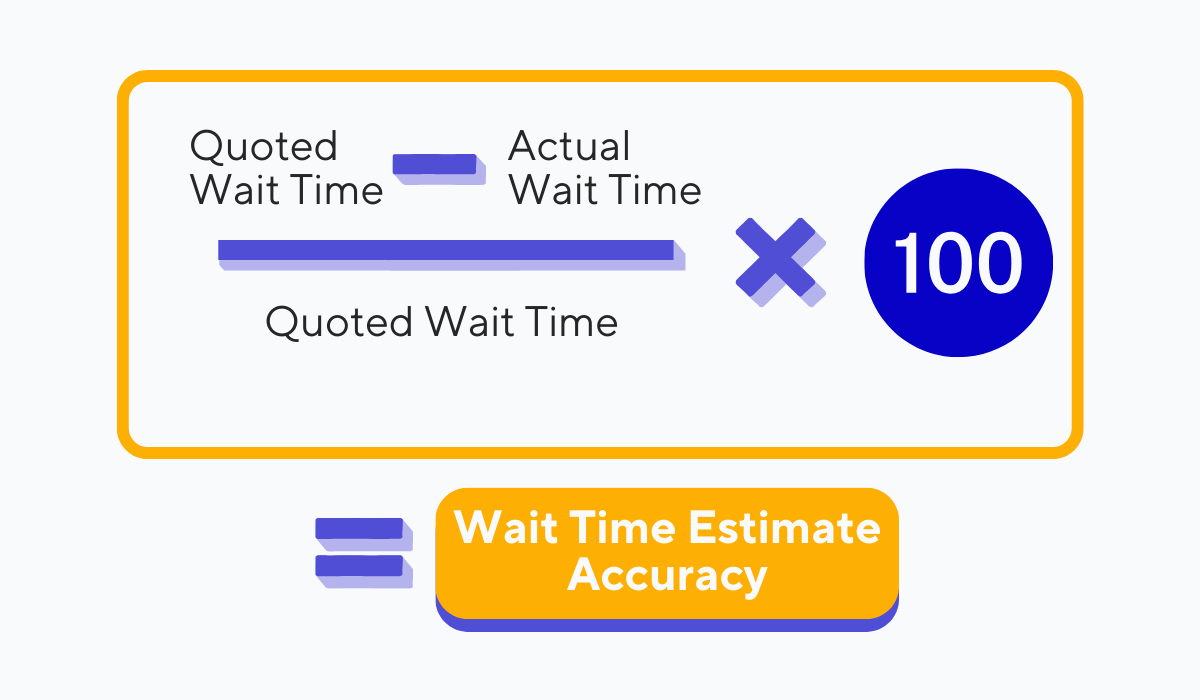
Source: Tablein
The image above displays a simple calculation to gauge the accuracy of your wait time estimates as a percentage.
Hitting 100% may be a long shot, but you can still strive for an accuracy of around 80%.
Now, here’s an important note.
Even if your time estimates are perfectly accurate, consider giving a slightly more conservative estimate to guests. For instance, if you expect a wait time of 10 minutes, quote them 15 just to be sure.
Why? Well, as Qiuping Yu, associate professor at Georgetown University, wrote on the Harvard Business Review website:
If the estimate is just slightly pessimistic, it’s unlikely to increase the abandonment rate, and the pleasant surprise when their wait is faster than expected will have a significant positive impact on the overall customer experience.
In her studies, Yu found that while accurate and optimistic estimates make customers happy, not meeting these expectations can lead to significant dissatisfaction.
So, accuracy is key when providing wait time estimates, but when in doubt, you can slightly overestimate the wait.
Waitlist Turnover
Switching gears, let's talk about a metric that provides insight into table availability, occupancy, and the efficiency of your service.
These aspects of your operations are evaluated through waitlist turnover.
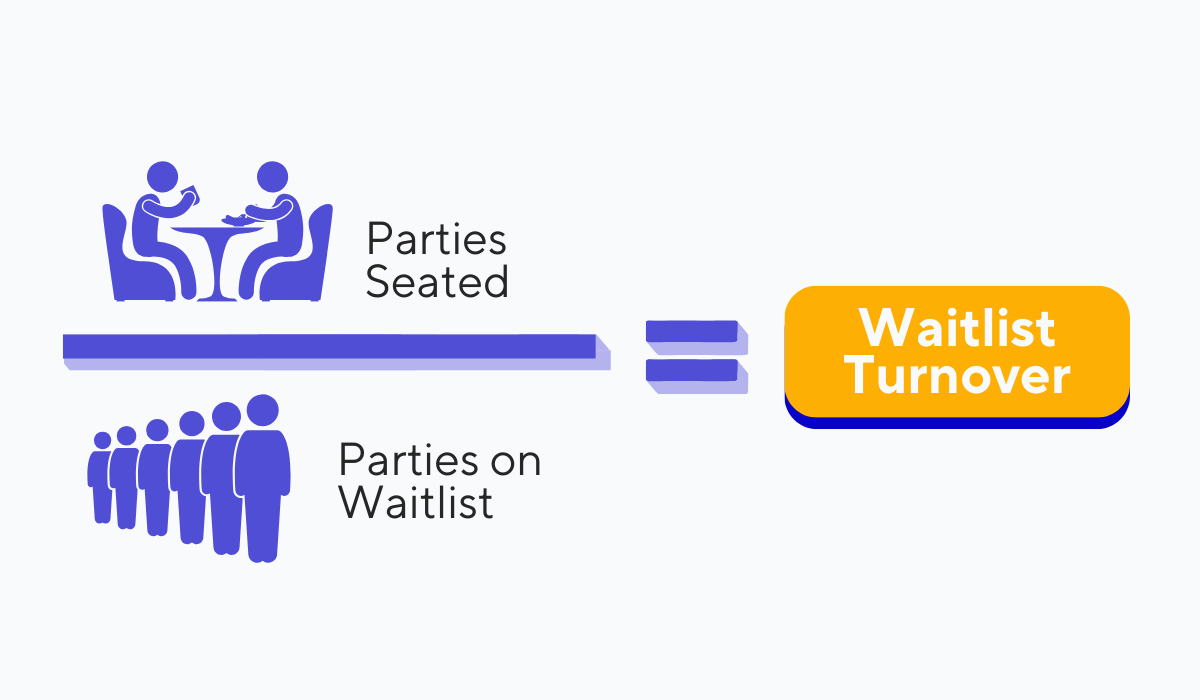
Source: Tablein
The image above shows you how to calculate this metric.
Choose a time period, e.g., during your dinner service, and divide the total number of seated parties by the total number on the waitlist.
Multiply this number by 100 to get the percentage, and that’s your waitlist turnover rate.
For example, if you seat 15 parties from a waitlist of 32, the calculation would be 15/32, resulting in a waitlist turnover rate of 46.9%.
A higher rate indicates quicker turnover and more efficient service.
Conversely, a low waitlist turnover rate can point to several underlying issues that affect the efficiency of your operations, such as the following:
As you can see, the waitlist turnover is a vital metric that can uncover some efficiency issues and bottlenecks in your service.
Waitlist Abandonment
Moving on to waitlist abandonment, this statistic can indicate how customers view your waitlist management practices.
Don't just write off guests leaving your waitlist as an unfortunate reality of a bustling restaurant with high walk-in traffic.
Rather, look at this metric as a treasure trove of information about customer satisfaction with your waitlist system and the potential revenue you're missing out on.

Source: Tablein
Calculating this metric is straightforward.
Just take the number of parties that abandon your waitlist within a set period, like in an hour or during lunchtime, and divide it by the total number of parties that join the waitlist.
Multiply the resulting number by 100, and you've got your waitlist abandonment rate.
For example, if 10 parties joined and 40 parties left your waitlist during a specific period, you'd have a 25% abandonment rate.
Ideally, you should aim for a rate of 10% or less.
To achieve this goal, work on improving your waitlist management by providing accurate wait time estimates, engaging waitlisted guests, and using digital restaurant waitlists to optimize this process.
Low waitlist abandonment means you’re doing something right, so keep track of this metric well and use the information to keep your guests satisfied.
Waitlist Performance Analytics
Let's pivot a bit and talk about how your waitlist metrics are interconnected pieces of a much larger puzzle.
While each metric we discussed so far can provide valuable insights on its own, by blending the waitlist metrics with other operational indicators, you gain a holistic view of your business performance.
Some restaurant metrics that you can pair with waitlist metrics are shown below.

Source: Tablein
By looking at all of these pieces of data together, you can identify correlations that might otherwise go unnoticed.
For example, a common finding is that a decline in average wait times could be linked to a rise in revenue.
In fact, as part of the study on the behavioral effects of long wait times that we presented in our first section, scenarios were explored where wait times were reduced or eliminated.
The result of no wait times was a significant increase in restaurant revenue.
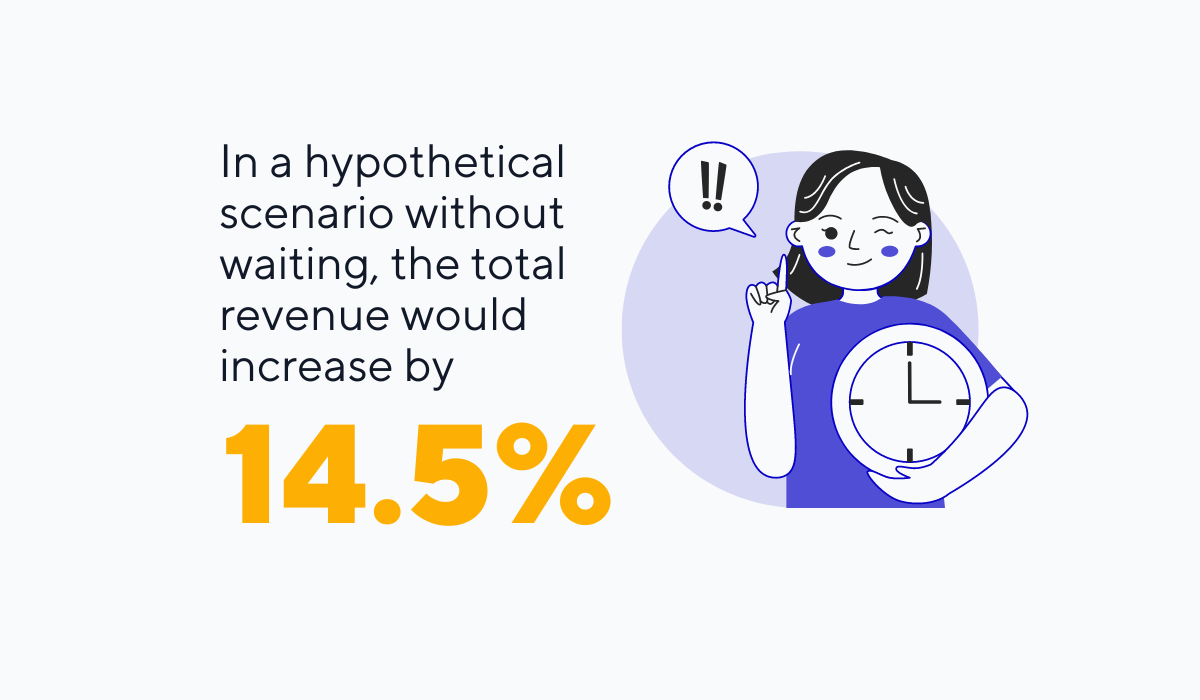
Source: Science Direct
While completely eliminating wait times is unrealistic, aiming to reduce them as much as possible can bring you more profits.
The same goes for the other restaurant metrics.
Consider how various wait times affect your customers, their satisfaction, and retention.
Long wait times can be a strong deterrent for repeat business and lost sales, something you can't afford to ignore.
Understanding waitlist performance in the context of your overall business metrics can offer invaluable insights, so delve deep into the data and use it to make informed decisions.
Customer Feedback
Finally, let’s not forget about your customers and their opinions on the quality of your service.
Customer feedback is the cornerstone of any improvement strategy, especially regarding waitlist management.
After all, if your customers leave your restaurant frustrated due to the way you handle the waitlist, you'll quickly find yourself losing both their respect and their patronage.
Your mission, therefore, is to pinpoint exactly how your customers feel about your waitlist system and what their specific needs and frustrations are.
Collecting feedback is vital for achieving this goal.
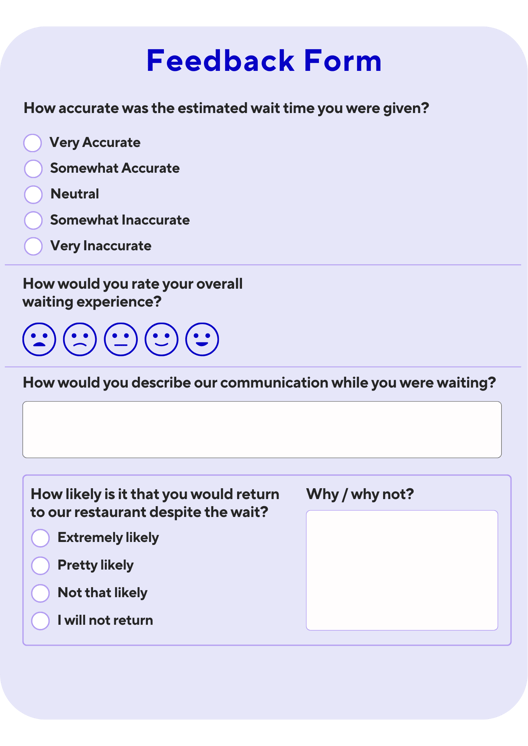
Source: Tablein
The feedback form shown above is a straightforward way to collect invaluable insights from your customers. But don't limit yourself to paper forms.
Keep an eye on your ratings and online reviews, as well as social media comments, particularly those that focus on the waiting times at your establishment.
The simple gesture of asking for feedback goes a long way with customers, as according to data from Microsoft, most customers will view you more favorably.
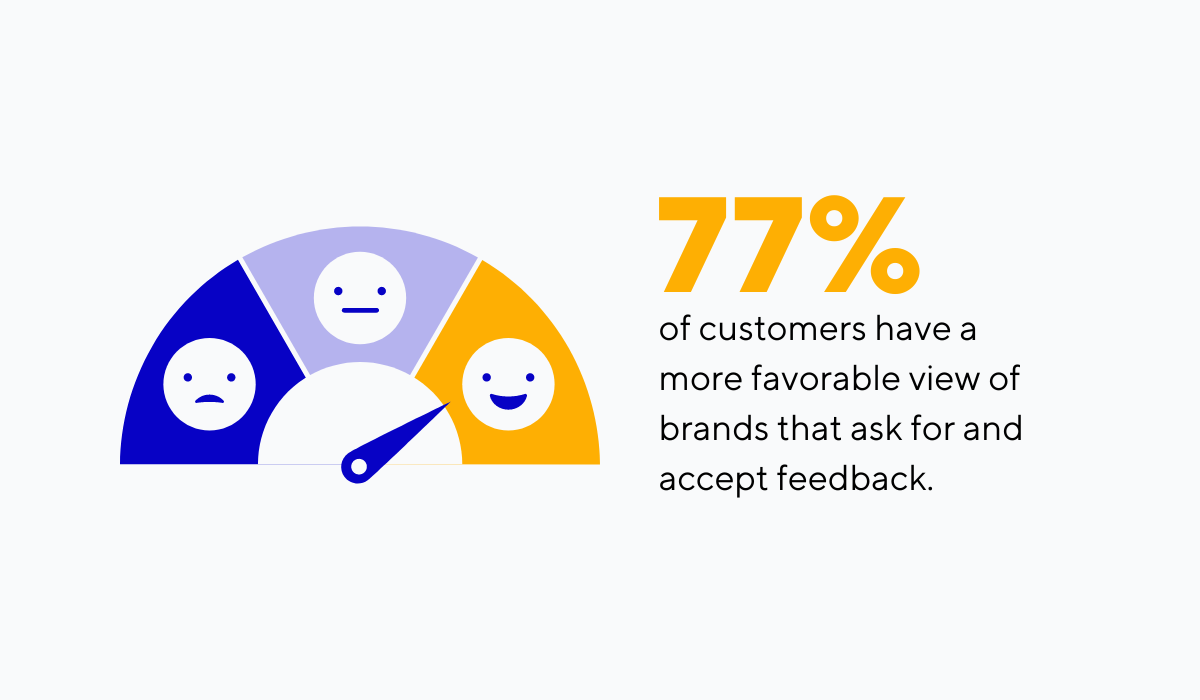
Illustration: Tablein / Data: Microsoft
But don’t just collect feedback just because your customers like it—take the gathered data seriously and act on it.
Consistently seek out customer opinions, analyze patterns and recurring complaints, and then use these insights to make the necessary adjustments to your waitlist system.
The importance of customer feedback cannot be overstated. It's your direct line to understanding your customers and their frustrations.
Use it wisely to fine-tune your waitlist strategies and deliver a customer experience that will keep them coming back.
Conclusion
In this article, we've explored six vital waitlist metrics, ranging from the average wait time your customers experience to waitlist abandonment and the all-important realm of customer feedback.
We hope that by now, you've gained some actionable insights that can help elevate your restaurant's operational efficiency and allow you to handle walk-ins with ease.
By carefully tracking these metrics and using their insights in your strategy, you're paving the way for smoother operations, better guest experiences, and, ultimately, more revenue.
So the next time you see a line out the door, don’t greet it with dread but with the confidence from data-driven waitlist management.
Get a 30-day Exclusive Trial
As a Tablein blog reader, you’re eligible for an exclusive 30-day free trial to experience our simple reservation solution for your restaurant.
Enter your business email, and we’ll send you all the steps needed to create your account.
Share this
You may also like

7 Common Questions About Restaurant Waitlists Answered

Guide to Restaurant Waitlist Management
